SKETCHING IN THE APPALACHIANS

BAHÍA DE CÁDIZ ISRAEL
NEW ZEALAND
SOUTH KOREA

SKETCHING IN THE APPALACHIANS

BAHÍA DE CÁDIZ ISRAEL
NEW ZEALAND
SOUTH KOREA
The official zine of Urban Sketchers JUNE 2023
Drawing Attention, the official zine of the Urban Sketchers organization, communicates and promotes official USk workshops, symposiums, sketchcrawls, news and events; shares news about USk chapters; and educates readers about the practice of on-location sketching.
Welcome to another issue of Drawing Attention, the zine about urban sketching across the world.
Thanks to this month’s Drawing Attention
contributors:
Content P ubliC ation team: Anne Taylor, Jane Wingfield
mailChim P layout: Jane Wingfield
i ssuu layout: Anne Taylor
Writers: Monique Chaim, Jane Wingfield

Proofreaders: Miguel Chavez, Sylvie Kaos, Mona Kwon
Contributors: Carolyn Daut, Eric Ngan, Parka
Cover image: Carolyn Daut
Subscribe to Drawing Attention. Read the March edition of Drawing Attention
CirCulation: 14k+ r eadershiP: 16k+ Web: urbansketchers.org
Urban Sketchers is a 501(c)(3) nonprofit organization dedicated to fostering the art of on-location drawing. Click here to make your tax-deductible contribution via Paypal. © 2023 Urban Sketchers.
Disclaimer: The views and opinions expressed in this publication, including accompanying artwork, are those of the authors and do not necessarily reflect the official policy or position of the Urban Sketchers organization.
Here at DA, we don’t like to create FOMO – fear of missing out – but we had to take one quick look back at April’s Auckland Symposium –perhaps all the more special because three previous Symposiums had been cancelled since Amsterdam in 2019.
French urban sketcher Oliver Hoeller said it “felt like drinking sketching from a firehose!” Auckland made a huge impression on many Symposium firsttimers, including Onion Oh from Suwon, who drew 380 people during her four days in the city (below right).

Meeting people from all over the world who share a passion for urban sketching was unforgettable. The event organizers, our hosts in Auckland, and the large team of volunteers did a truly superb job making us feel welcome and looked after. Ngā mihi nui to everyone!
Back in our home towns, life is probably not quite so exciting but we all know we don’t have to travel overseas to find things to draw. This issue, we meet sketchers in Bahía de Cádiz who have so much beauty and variety right on their doorstep. Inhong Park has a heartfelt connection to the
traditional ‘hanok’ architecture in her homeland of South Korea, and the countryside there. Carolyn Daut took a life-changing trip in her own country, walking and sketching the 2,000 mile Appalachian Trail over five months.
You can check out more possible trips and regional events but make sure you enjoy what you do at home, too: Irena Spector has a great exercise you can try, and there are a range of new books to get into, as well.
Thank you so much to everyone who contributed to this issue, including new volunteer proofreaders Miguel, Sylvie and Mona. A big part of urban sketching is sharing our stories with others, so please get in touch with us; we are always interested to hear from you. Wishing you much inspiration!
Anne Taylor (NZ), with Jane Wingfield (USA) Content Publication Team
drawingattention@urbansketchers.org
















A huge thank you to everyone for making this 11th USk Symposium such a positive and unforgettable experience.Our project team had an aim to embody the Māori term of manaakitanga, which means to host with kindness, hospitality, and generosity. This unfolded as an undemanding task when all participants came to New Zealand with open



“New Zealand is a unique and beautifully diverse place. Not only with its scenery but also its culture.
As a Symposium location, Auckland had a welcoming community, wide open spaces, a deep connection
drawing attention
with nature, and endless views to sketch. The weather could change in a day, an hour, or a walk around the block! Instructors, participants, volunteers correspondents, and organizing team were game to

hearts and keen energy. The Māori name for Auckland is Tāmaki Makaurau, translated as “the place desired by many”. That description rang true when we had 444 urban sketchers from 31 different countries immortalizing Auckland in sketchbooks. Planning now gets underway for the 12th USk Symposium in Buenos Aires, Argentina, from 9 to 12 October 2024. Let’s get ready to tango! Arohanui / much love to one and all, and keep on sketching. Kind regards, Eric Ngan, USk Events Director

adapt to new locations, plunge to plan Bs, and had a great adventure. It was a delight to see the power of community work and play hard! Witnessing the planning and putting together of the event, I am
grateful and in awe of the teamwork, camaraderie and generosity of everyone who contributed to make it happen. Onsite and behind the scenes, thank you!”
Maria Regina Tuazon USk Communications DirectorMany sketchers got their first experience of Māori culture at the Symposium. The performances for the opening and closing ceremonies were spine-tingling.
Above is Raukura Kapa Haka, the resident troupe at the Auckland War Memorial Museum.

Jana Hoffman – Auckland

Nothing was too much trouble for Jana and the rest of the awesome volunteer team. Friendly, helpful, and cheerful despite their heavy workload, they were a big part of the magic of the Symposium. They showed the very best of New Zealand manaakitanga (hospitality, kindness and support).


Mário Linhares – Lisbon
An ever-present feature of the Auckland cityscape, the 328m tall Sky Tower captivated many sketchers. The second tallest building in the Southern Hemisphere, it is lit up at night in different colours to mark different occasions. The red signified the forthcoming ANZAC public holiday. It was struck by lightening in May! Mário showed just what’s possible when you unleash creative freedom on the page.


Pavithra Devadatta – Wellington
Pavithra made this jacket specially for the Symposium. “I grew up in a tropical climate, so I feel the cold here when I’m sketching,” she says. She has made many jackets from recycled wool blankets, adding applique and embroidery. Doing her chapter proud, this one is decorated with motifs from the capital city, including Wellington’s well known red cable car.


Keesung Song – South Korea
A major challenge for many of us –particularly newbies – was managing all our gear on location. Keesung showed me his clever three-part water container, while on Maru Godas’ ‘Flowing Cityscapes’ workshop. Made in Korea from lightweight plastic, the three pieces fit inside each other when not in use.



Genine Cavalheira – Colombia
USk President Genine was gifting chocolate covered coffee beans to lucky sketchers. Fresh from Bogota, the cute boxes were decoated with the national colours. Symposium days were packed with events and catching up with other sketchers so these treats hit the spot! Of course, the ultimate treat was seeing the 2024 Symposium announced...

• JUNE 9-11: BARCELONA, SPAIN
10th anniversary of the Urban Sketchers Symposium in Barcelona
• JUNE 23-25: DARMSTADT, GERMANY
The Urban Sketchers RheinMain chapter celebrates its 10th anniversary.
• JULY 7-9: CHICAGO, USA
USk Chicago Seminar is also back this year after the pandemic hiatus.
• JULY 14-16: EDMONDS, WASHINGTON, USA
Sketcher Fest Edmonds - The first ever travel sketchbooks festival coming to the U.S.


• JULY 15-16: TORONTO, CANADA
10 x 10 Workshops celebrating Toronto’s 10 year Anniversary
• JULY 16-22: INTRAGNA, SWITZERLAND
4th Urban Sketcher Week, with workshops by Lis Watkins, Nicola Maier-Reimer, Sylvain Cnudde and Ryan Little.
• AUG 12-15: POLAND
Urban Sketching Festival in ŚwidnicaWorkshops, sketchwalks, lectures, exhibitions, various competitions, goodies and stands with art materials. FB: Urban Sketching Festival Świdnica, Instagram: @uskpoland
• SEPT 1-3: BERLIN
7th Annual Urban Sketchers Germany Meeting
• SEPT 9 & 10: JOHANNESBURG, SOUTH AFRICA
Urban Sketching the City of Gold Mini Symposium hosted by Urban Sketchers Johannesburg.
• SEPT 21-23: PLAUEN, GERMANY
Urban Sketchen Plauen - sketch walks, workshops, gallery forums




An exciting sketch event will be held in the city of Itu, Brazil, on 8-11 June 2023, thanks to organizers winning a #USkRegionalEvent. The evented is hosted by @uskituoficial and @usksaopaulo to cover the Southeast region of Brazil.
Only an hour away from Latin America’s biggest city, we will be sketching this charming town. We will have a fourday event with six workshops and six sketchwalks, offered free of charge for 120 participants.
Our workshop instructors are: Catarina Churakova @catarina_chur; Eduardo Bajzek @bajzek; Eliana Bianco @elianabianco_watercolors; Lauro Monteiro @ lauromonteirofilho; Renato Palmuti @renatopalmuti and Flavio Ricardo @flavioricardo1978.
The deadline for a free pass is 2 June. A big thank you to @urbansketchers and our generous sponsors.
featured chapter
It all began during a painting workshop at Plaza de Candelaria, over midday coffee. The plaza is a quiet square in the city of Cádiz, Spain, filled with plenty of foliage and shady spots to sit and people watch. Founders José, Mar and Celia wanted a way to unite those who had a passion for drawing like themselves; to create a meeting point to share and learn from one another. They also thought it would be a nice way to get to know the bay area (Bahía) through drawing. This is how Sketchers Bahía de Cádiz was born. It now has around 65 members, with an average age of 50 years, and the group meets on the first Saturday of the month as well as every Thursday morning.
The city of Cádiz is located in southern Spain in the Autonomous Community of Andalusia. It is a narrow strip of land that extends out from the mainland and curves around to protect its bay. It is believed to be the oldest city in Western Europe, being founded by the Phoenicians more than 3,000 years ago (named back then as “Gadir”). It was a main port for trade, making it a melting pot of Roman, Visigothic and Muslim cultures. Cádiz is known for its beautiful beaches, architecture, and its hospitable people who have a great sense of humour. Urban sketchers will especially love to get lost in its narrow streets, capturing the light and beauty on paper.
USK Bahía de Cádiz is a passionate and diverse group. There are teachers, architects, draftsmen, as well as doctors, nurses, and dancers. The materials they use are equally diverse, ranging from markers, watercolors, and inks, to collage and wax.
“The most important thing about our group is what we all learn from each other: techniques, color, composition, etc. We share what we do, how it is done, and what is intended from both sides: the person who is interested and the person who is sharing. The exchange of information and feedback has been the best aspect of the group. In addition, new sketchers feel welcomed and keep coming to draw with us every day. Community sense and support is granted.”
SKETCH BY ARTURO CALETA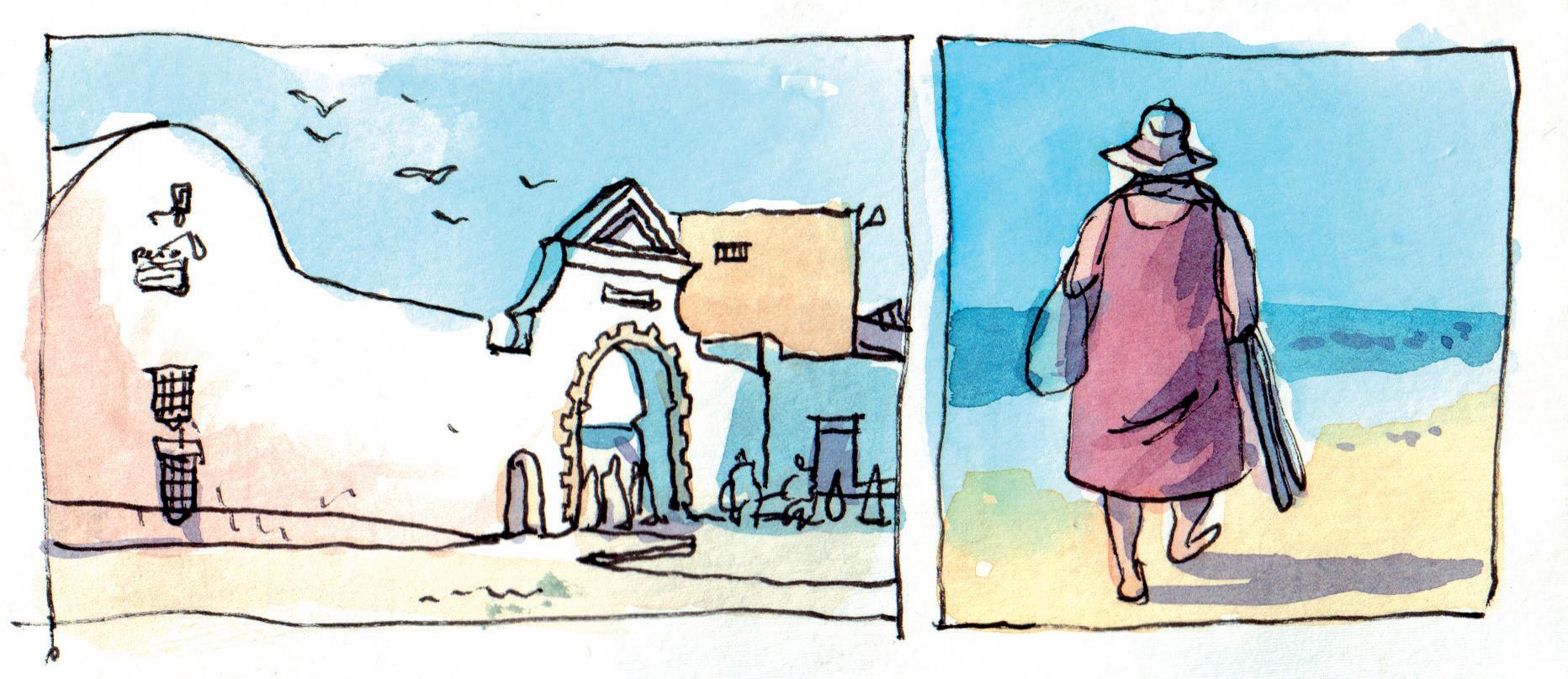

“The most important thing about our group is what we all learn from each other...”











We love to hear about your chapter’s news, special events, joint meetups, and exhibitions and share them with our readers. Contact us at: drawingattention@urbansketchers.org.

 BY CAROLYN DAUT
BY CAROLYN DAUT
I WROTE ABOVE MY SKETCH, “IT FEELS LIKE MY LIFE IS GOING TO CHANGE AS SOON AS I WALK OVER THIS BRIDGE”. THAT WAS THE FIRST HOUR OF MY FIRST DAY ON THE APPALACHIAN TRAIL.
It was on a cool spring morning in 2021, sitting on a wooden bench looking over the Potomac River in Harpers Ferry, West Virginia. I sketched the scene: the flow of the river, green hills in the distance, and a bird sitting on crumbling bridge foundations. The path that would lead me forward into something new and unknown was laid out in front of me.
The Appalachian Trail, or “A.T.”, is a continuous footpath that stretches along the east coast of the United States of America. The A.T. is 2,193.1 miles (3,529.4 kilometers) long and includes 515,000 vertical feet (156,972 meters) of elevation gain and loss. That elevation is equal to summiting Mt Everest 16 times! The promised beauty of the American wilderness is tempered by dangerous terrain, difficult trail conditions, and inclement weather. The success rate of hikers finishing the A.T. remains around 25%. I wanted to join that exclusive club, and I wanted to do it with sketchbooks and watercolors in tow.
I added new micron pens to my food resupply boxes and curated my travel watercolor set to best reflect the dreamy green and brown landscapes I would encounter. I had to carry everything I needed on my back, often for eight hours a day or more, so the weight of every item was scrutinized and pared down. The heaviest art supply item ended up being the sketchbook itself. To save weight, I deconstructed then sewed together a series of 30-page sketchbooks. When one book was completed, I would mail it

home and start fresh, looking forward to where the next bend in the trail would take me.
It took me five months to backpack the entire A.T. I walked in the snow, rain, sleet, and sun. I walked over mountains and through valleys. I walked until I bled, until I laughed, and until I cried. These sketchbooks joined me for the whole adventure. I filled every page with art and observations drawn on location. When I arrived home, footsore and hungry, I sewed the books back together. The result is a 200-page
journey through the Appalachian Mountains as I found strength through art and adventure on this infamous American footpath.

It wasn’t easy to keep up with both the hike and my artwork. It was not uncommon for me to have a string of rainy days with nothing more interesting to draw than the inside of my tent, or to feel so hurt and exhausted that creativity felt out of reach. Through each trial and during every bad day, I picked up my pen and let the drawings flow.
This sketchbook is as real and raw as I could possibly make it. I didn’t try to capture just the big trail highlights, or paint vista after vista. What I attempted was to capture a few moments in time that when viewed all together might allow some glimpse into the mundane and extraordinary life of a long-distance hiker.
When I think about what I’ve accomplished, and how it was to be out there on the Appalachian Trail, I feel it in my chest like I’m about to laugh or cry. It’s almost painful and it’s hot to the touch. It was the experience of a lifetime, but not one that I had and now is left behind on the last summit. I think that is what makes these sketchbooks so special to me. I was able to catch some part of who I became over the course of this journey and press it between the pages of a book like the dried flowers I used to hoard as a girl.
I changed, the moment I drew my first sketch and took those first steps. How, exactly I will continue to change is still out there for me to discover.














IRENA SPECTOR SHOWS YOU HOW TO RELAX AND PLAY WITH WATERCOLOUR PAINTS, TO CREATE A DYNAMIC URBAN SCENE.

Fear of watercolor is a very common problem for sketchers because watercolor behaves unpredictably and is difficult to manage. Too many adjustments lead to messy and unattractive results. With my technique, I try to overcome the fear and turn my watercolor work into a play, without worrying about precision. I also use watercolor pencils to depict the contours. They partially dissolve in the process of work and this gives the sketch a feeling of lightness and incompleteness.
Step 1: I wet the paper and make the first big washes (wet into wet) using very light colors. This step allows me to overcome the fear of blank paper and allows the watercolor to set the mood.
Step 2: When the paper is still wet, I outline the buildings and the human figures. I don’t try to be very precise, I use a light blue watercolor pencil which allows me to make corrections easily, if needed but, more importantly, this gives a very pleasant feeling while drawing on wet paper.
Irena was born in Odessa, Ukraine and graduated the Grekov’s art school in 1988. In 1990 she immigrated to Israel, continuing her art education alongside a degree in medicine, specializing in psychiatry. She combines work as Senior Psychiatrist in Tel Aviv Medical Center with watercolor painting and watercolor instruction activities. She loves watercolor’s transparency, unpredictability and the wat it can capture light effects.
• Watercolor paints, usually up to 4-5 colors: ultramarine blue, naples yellow, cadmium red, cadmium orange, ceruleun blue
• Watercolor pencils
• White gouache for highlights.
• Don’t be afraid of making mistakes – sometimes they can lead to new discoveries. For example you can make a bird from an accidental spot of paint.
• Start with spontaneous splashes of color, especially when you are not sure about what to paint first. The splashes of color will lead you and will give you ideas.
• Enjoy the process, play with the colors and experiment with different color combinations.

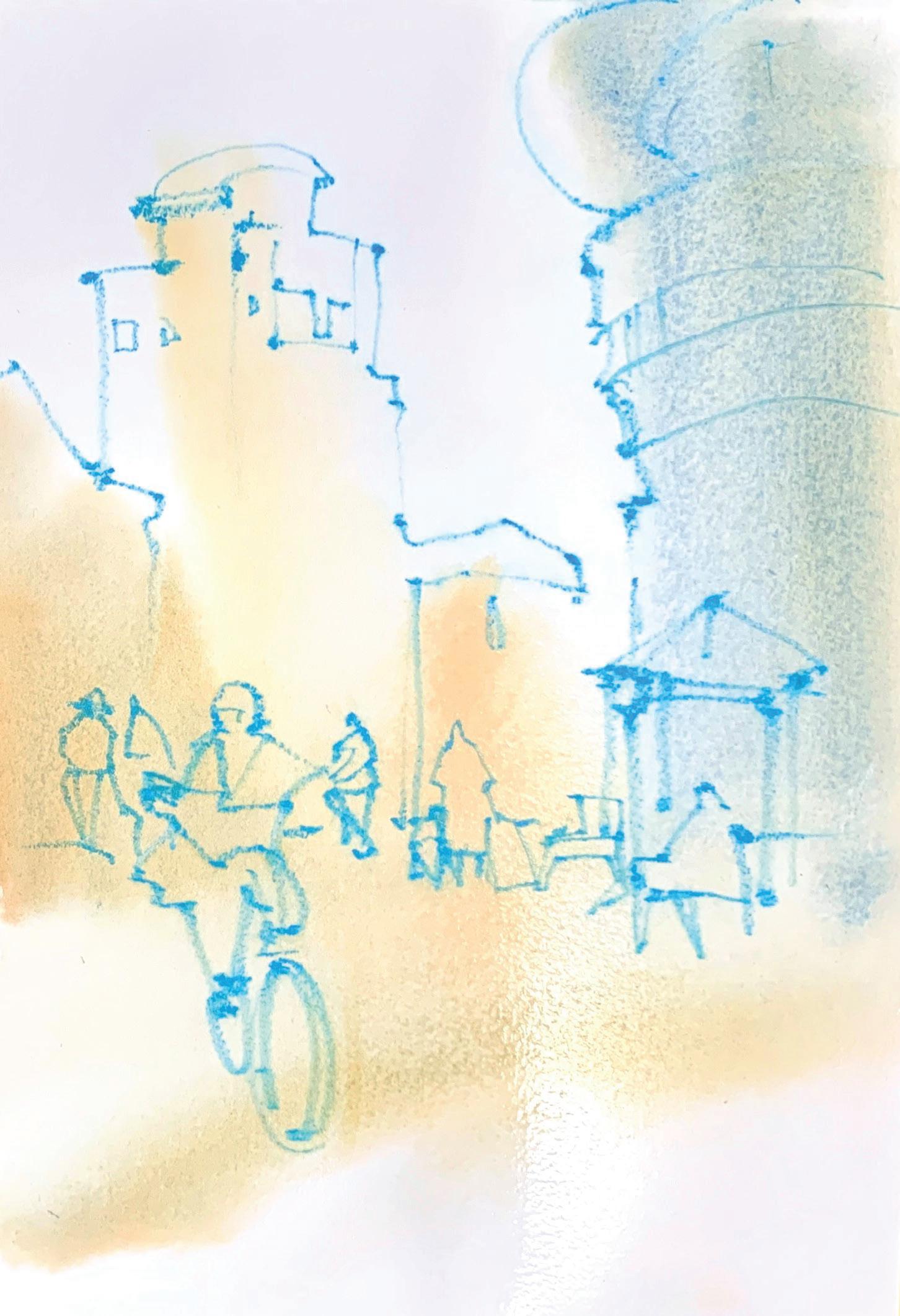
Step 3: Next, I wait for the paper to completely dry and then add the second wash to denote the large forms, such as the sky, tree and shadows on the buildings. This time I’m working on dry paper and this allows me to be more precise and to outline the figures. I use a mixture of colors (yellow, ceruleun, ultramarine and cadmium red) and allow them to mix one into another on the paper.

Step 4: Once again it is necessary to wait for the previous layer to dry completely, and only then I start to add details with a smaller brush, such as the shadows of the bicycle and figures, and the colorful clothing.

Step 5: I continue with the details, this time more graphic: the tree, adding further details to describe the figures. I combine a dark watercolor paint mixture (indigo, ultramarine, cadmium red) with a dark watercolor pencil (dark blue, indigo).
Step 6: Finally, I add some accents with a white pencil and white gouache. This has to be very subtle. You can see it at the shoulder area of the figures and in the background (signboards, pointers), for example.

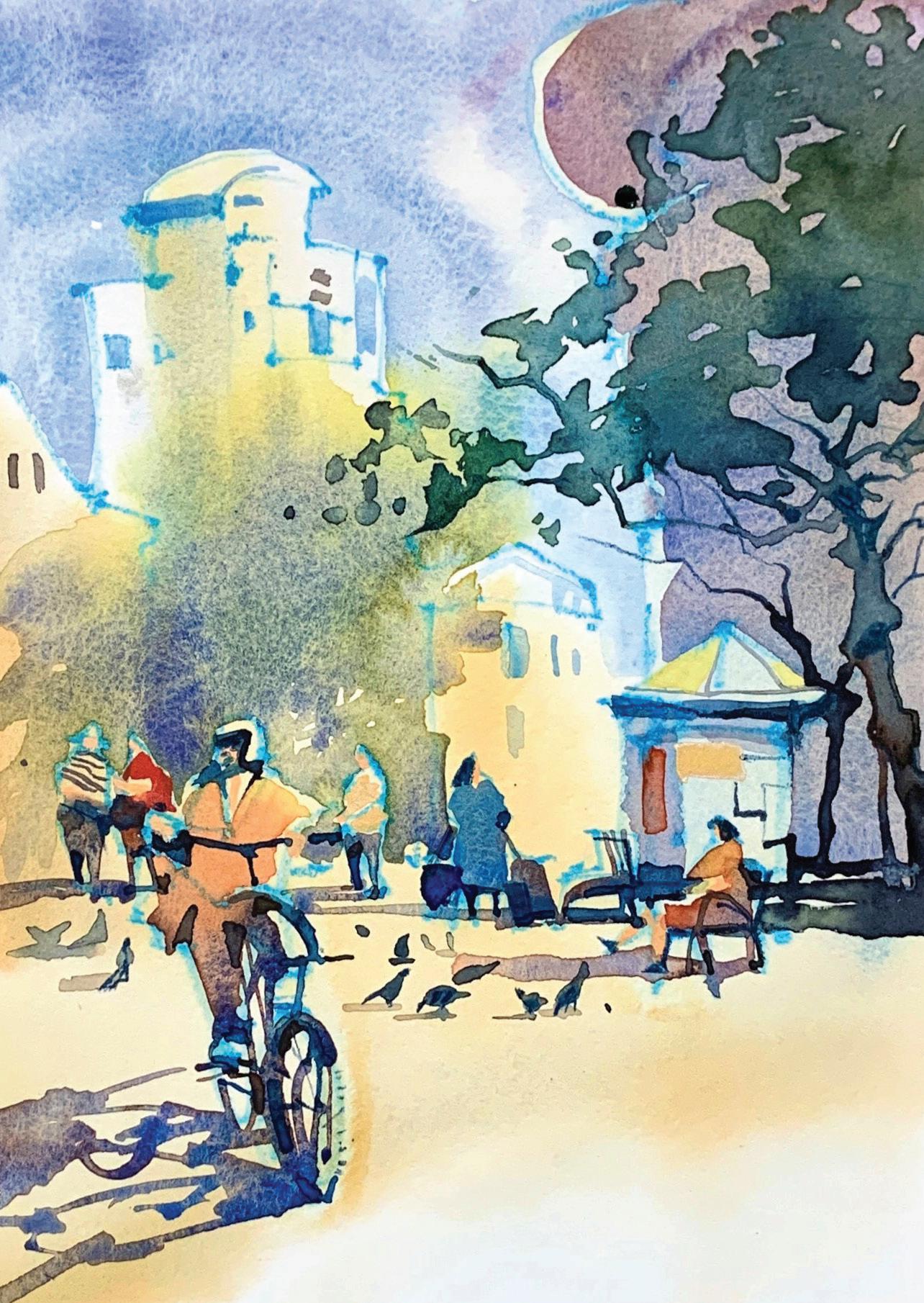

INHONG PARK DESCRIBES HERSELF AS A “FULL TIME DRAWING ARTIST”, AND WORKS ACROSS MANY DIFFERENT FIELDS – BUT NATURE AND HER LOCAL SURROUNDINGS IS WHERE SHE FINDS HAPPINESS AND INSPIRATION.
 BY JANE WINGFIELD
BY JANE WINGFIELD
Ireached out to Inhong while she was traveling and camping in the Korean countryside. “Korea is surrounded by the sea on three sides and there are many mountains in the interior,” she says. “For me, liking nature, country camping gives me a break and inspires me. I was born in the city, but when I go to the countryside, I feel comfortable as if I were in my hometown. Kind people, quiet and cute houses, and beautiful scenery”.
Korea has a long history and many interesting traditions, explains Inhong. “There are many centuries-old traditional buildings in downtown Seoul and Incheon. We call the traditional Korean buildings ‘hanok.’” The curved roof hanok is Korea’s architectural heritage. Inhong describes it as having “beautiful curves, colors and a harmony with nature.” The contrast between straight lines and curves, and old and new is especially compelling for sketchers. “There are places where you can enter the hanok, parks, and cafes, so all of them are good places to sketch,” says Inhong.
As an illustrator, she collaborates with many companies, organizations, and public institutions, and as an instructor, gives lectures at schools, libraries, and art galleries. She is currently working on two books – one as a personal project and one for a publishing company. She also runs renhong sketchclub and teaches watercolors and pen wash drawing.
Inhong most often participates with the Seoul chapter. “USk Seoul is very crowded and passionate! If you participate in it, you can interact with many skechers and see various paintings. There are also many chapters in Korea. The distance between cities is not far, so it is easy to move around, so you can come and go often.I have been to USK Incheon, Pohang, Ulsan, Busan, Paju, and Suwon meetings.”

A fashion designer by training, Inhong painted in oil and acrylic, and created many picture diaries. “Sketching has been my daily routine since I was young,” she says. She spent some time working in China after graduating.
“At that time, every day I worked hard and I was lonely.” She found urban sketchers drawing in the streets of Guangzhou in southern China and for the first time drew outside with the group. “USk Guangzhou friends were very passionate and sincere about urban sketching. We got closer to each other through sketching. Even after I returned to Korea, we are still in touch and we decided to meet at Asia Link in Suwon this year.”
Korea is also hosting two major festivals this year. The largest urban sketch event in Korea, Gyeongju Festa is in June. In October Suwon will host Asia Link, an Asia-wide sketching festival. This is the first Asia Link since COVID and there is much anticipation and excitement for its return. Inhong will be teaching at both events.

Inhong is preparing to publish a book about a trip she took to Portugal. She shared shared one of her favorite memories of Portugal: “I went on a trip to Porto alone in the summer of 2022. At that time, I was walking down an alley where there was no one, and then I met someone sketching alone on the street.”
They didn’t recognize each other but when they looked at each other’s sketchbooks they immediately recognized each other’s work. “He was Hugo, an instructor at the symposium. We were already following each other on Instagram. After that, we went around to sketch together and became friends.” Urban sketching really does connect the world; the world becomes closely connected through urban sketching.

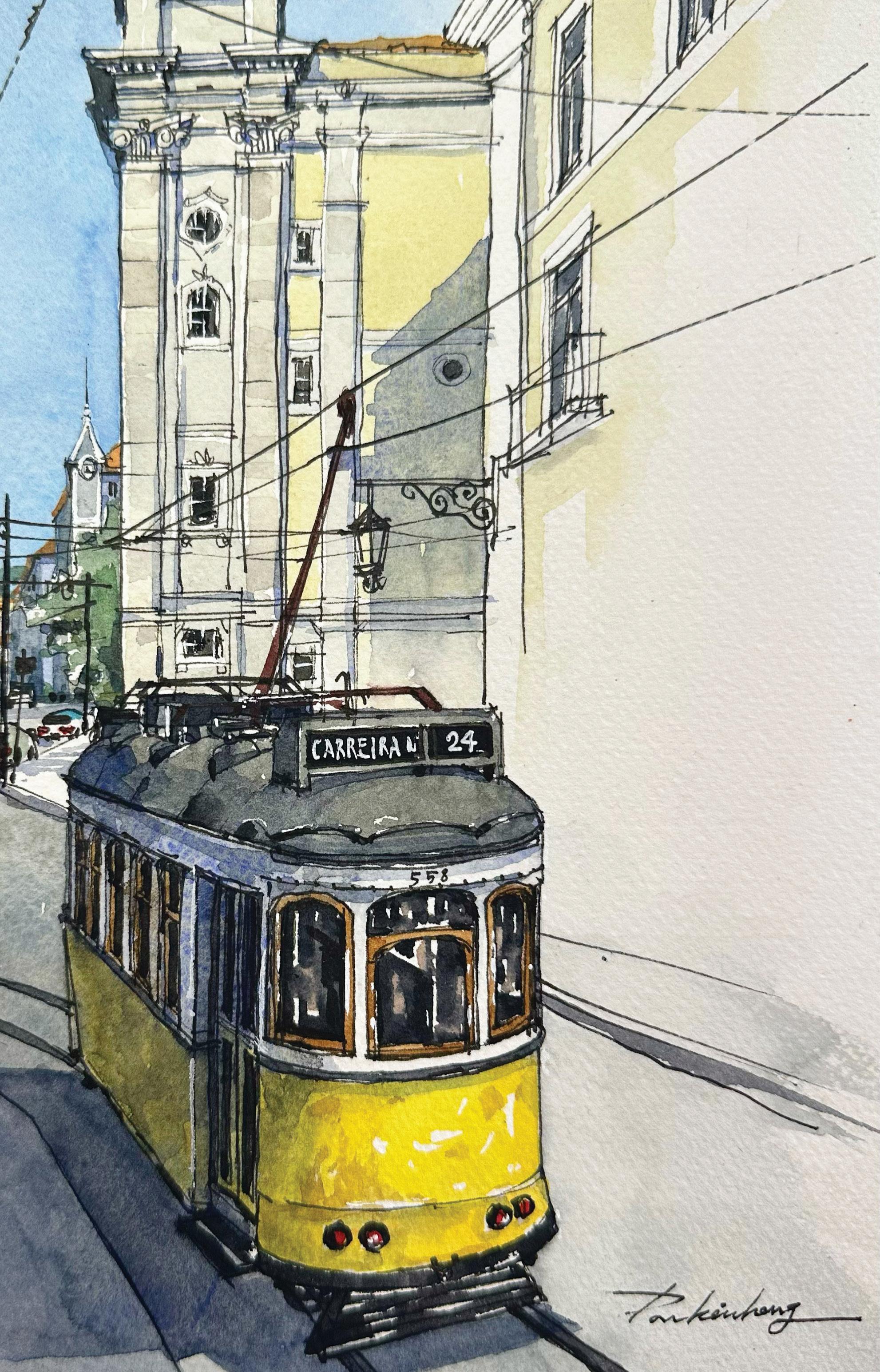
in the city, but when I go to the countryside, I feel comfortable as if I were in my hometown.”
It’s very difficult to draw everything you see in a sketchbook when you’re doing a urban sketch. Ask yourself what parts do you like, what makes the strongest impression among the things you see. When you do that, the composition, the color, the form, everything will be natural.
I don’t want to cause inconvenience to passers-by when I sketch. Be careful not to get in the way of people walking on the street, not to block the scenery where there is a good view, and not to be noisy in quiet residential areas. What I see beautifully looks beautiful to others, so I have to share it with them. I try to naturally immerse myself in the landscape and sketch without disturbing the local people.
When I sketch by myself, I take a position so that I don’t stand out too much, and I always sketch in a safe place.
그림을 그린다면 구도, 색상, 형태, 모든 것들이 자연스러워 질
것입니다.
저는 스케치할 때 행인들에게 불편을 끼치고
싶지 않습니다. 길을 걷는 사람들에게 방해가
되지 않도록, 전망이 좋은 곳의 풍경은
가로막지 않도록, 조용한 주택가에서는
소란을 피우지 않도록 조심하고 있습니다.
나에게 아름답게 보이는 것은 다른
사람들에게도 아름답게 보이기 때문에
풍경을 가로막지 않고 사람들과 함께 공유
하려고 합니다. 현지인들에게방해가 되지
않고 자연스럽게 풍경에 스며들어 스케치를
하려고 노력합니다. 또 혼자 스케치를 할
때는 너무 돋보이지 않도록 하고 항상 안전한
곳에서 스케치를 하고 있습니다.
“Iwas born


ABOVE: SKETCHES FROM THE AUCKLAND SYMPOSIUM

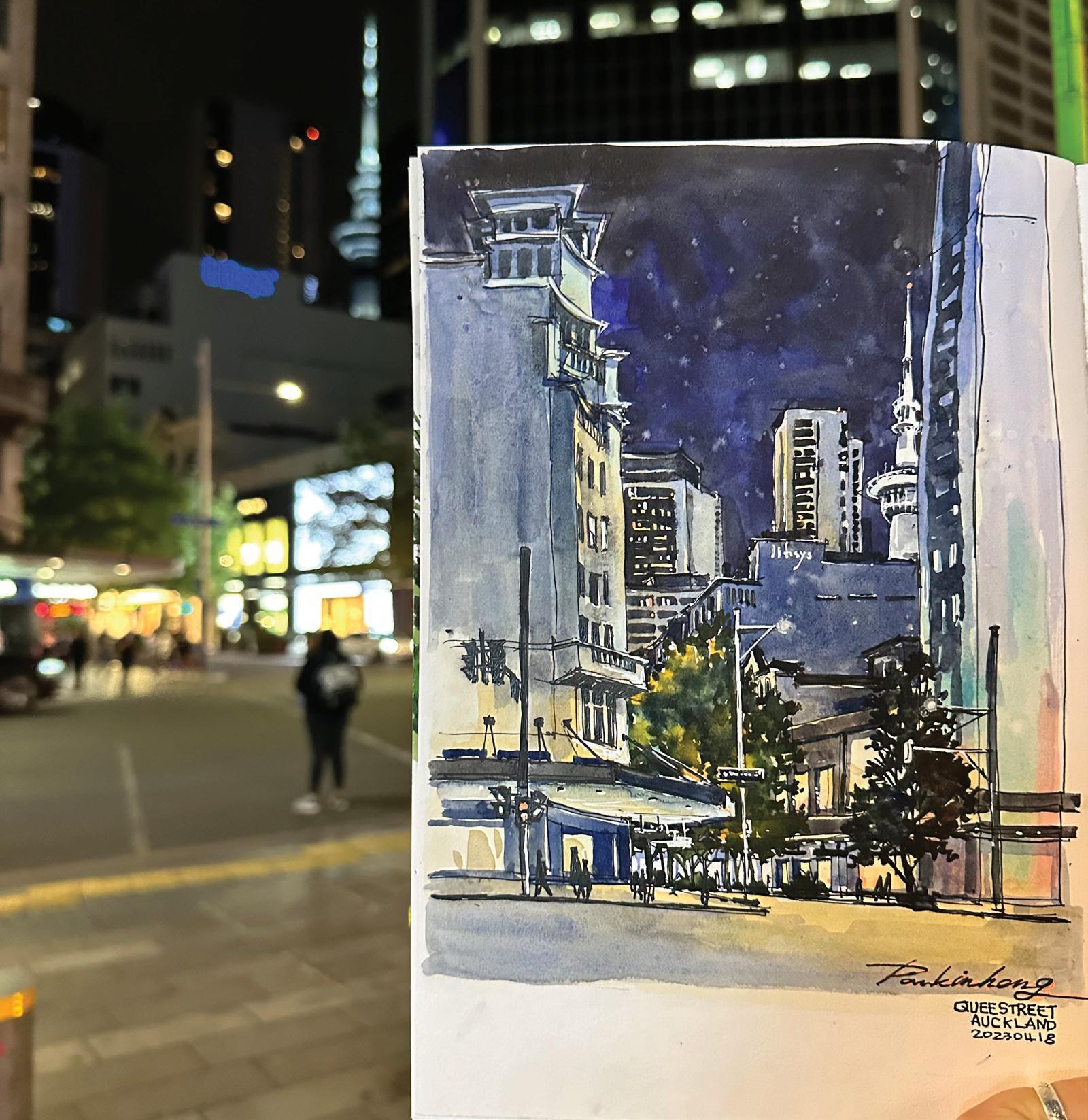

SUBSCRIBE TO DRAWING ATTENTION – IT’S FREE


WE ASKED THREE INTERNATIONAL URBAN SKETCHERS TO DESCRIBE AUCKLAND IN THREE WORDS AND TELL US WHAT MADE THE SYMPOSIUM SPECIAL FOR THEM...


Onion Oh, Suwon, South Korea
It was my first time attending a Symposium, and I flew all the way from Korea to get there. The trip was about 11 hours, but it was totally worth it. When I arrived, I started drawing pictures right away, (actually I started drawing even on the bus ride to the airport!) The whole experience was amazing. I stayed in New Zealand for about three weeks and got to travel around the South Island, where I saw a lot of animals (sheep, cows, alpacas and lots and lots of dead possums) and beautiful scenery.
But the real highlight was the Symposium itself. I got to meet so many new people and make a ton of new friends. In fact, I challenged myself to draw everyone I met, and I ended up drawing 380 people over the course of four days – and there were still more people I have not met yet! It was such a great opportunity to connect with other artists and see all the different perspectives and styles they brought to the table.
And of course, the drinks were flowing and the food was amazing. I really enjoyed Drink and Draw, the local wine and lattés, and the cheese was out of this world.
Most importantly, I learned so much at the Symposium. There were so many amazing artists there, and I was able to pick up new techniques, styles, and materials that I had never experienced before. It was truly a turning point in my life as an artist, and I left feeling inspired and invigorated to keep improving my skills. The Symposium really opened my eyes to new possibilities and helped me realize that there are no limits to what I can create. I am so grateful for the opportunity to attend and to have met so many talented and friendly people. It was an amazing event, and I would highly recommend it to any artist looking to expand their horizons and connect with others in the community: an incredible experience that I’ll never forget.
I am extremely grateful to the organizers for putting together such an incredible event. They did an amazing job of bringing together so many talented and diverse artists from all over the world, and creating an environment where we could all learn and grow together. The attention to detail and care they put into every aspect was inspiring, from the workshops and presentations to the food and accommodations. It’s clear that they are passionate about supporting the arts and fostering a sense of community among artists. I feel incredibly lucky to have been a part of it, and I want to express my deepest thanks.

The best part of the Symposium was the enthusiasm, knowledge sharing and camaraderie between all the lovely sketchers. The organizers managed to integrate local NZ culture very well, from making varied posts on the Facebook group well in advance, to the Māori performances at the opening and closing ceremonies. This was my fourth Symposium. It was extremely well organized, and the venue was perfect, with room for everyone.
A favorite sketching spot in Auckland was drawing the amazingly expressive Moreton Bay fig trees in Albert Park, Auckland, and later painting misty mountains and vivid autumn colours in Queenstown. We had some wonderful servings of lamb and some great wine on our trip. An unexpected bonus was that my wife and I met Ruth Shawthe best bookseller in her tiny “Wee Bookshop” at the end of the world in the small village Manapouri in the South Island. We both read her book The Bookseller at the End of the World , with her touching, dramatic life story.


DURING MARU GODAS’S WORKSHOP

massive highlight. Sharing sketchbooks, techniques, stories and above all seeing that excited energy when we finally met the sketchers who we regularly follow and admire on social media.

politely move away while they filmed, but instead they wanted to film us sketching the gallery. So now, Auckland has become a destination for sketching within that travel blog!



Sketching the Auckland Art Gallery building was a must-do sketch for me. It was also a sketch that ended up with an interesting and unexpected story. As I was sitting with my friend Judy Salleh amongst a few hire bikes and traffic cones sketching the gallery, we were approached by a UK film crew who were filming a travel blog for Singapore Airlines. I expected them to ask us to
Sally Black, Canberra, Australia
Auckland was my first international Symposium. I had a pretty good idea of how the event would run as I have been to two USK Asia Link events – one in Kuching and the other in Taichung. The excitement and buzz that was evident amongst the sketchers was a




JANE WINGFIELD BRINGS YOU HER PICKS FOR MID-YEAR READING.

THE BURTON ROAD SKETCHBOOK
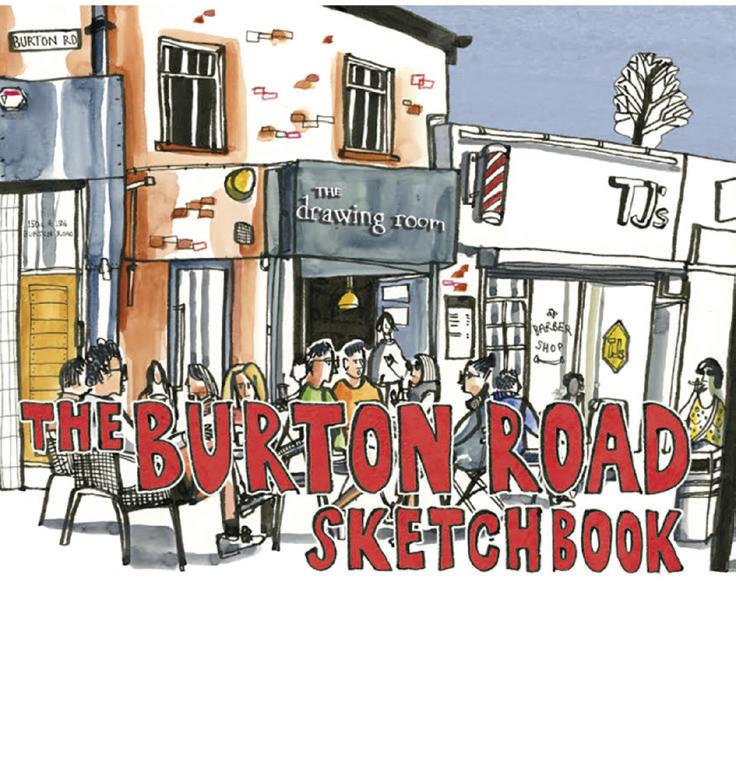
LEN GRANT
DIFFERENT AND THE SAME: MY DRAWINGS AND STORIES OF WOMEN AROUND THE WORLD

MELANIE REIM
PAGES IN THE WIND: URBAN SKETCHING IN TE WHANGANUI-ATARA WELLINGTON EDITED BY ANNE TAYLOR

PATROUILLE DE FRANCE: DE L’INSTRUCTION À L’EXCELLENCE LAPIN

ZARAGOZA LAPIN

AOÛT EN VAL D’AUBOIS LAPIN

Teoh Yi Chie is an infographics journalist who joined Urban Sketchers Singapore in 2009. He’s probably better known as Parka from Parkablogs.com, a website that reviews art books and art products.
This month Parka reviews Tools and art supplies for black and white sketches. Check it out!

Teoh Yi Chie was on the spot at the Auckland Symposium, and here he shares what was in his sponsors goodie bag with us.
SEE MORE FROM TEOH HERE

• We draw on location, indoors or out, capturing what we see from direct observation
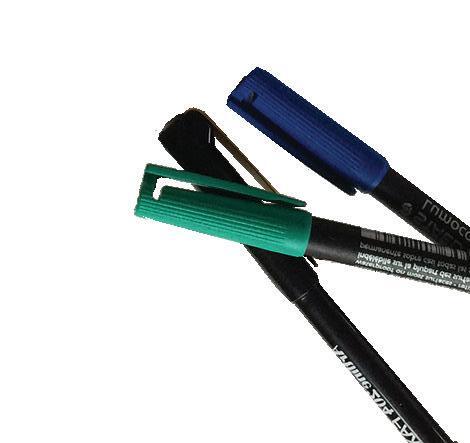
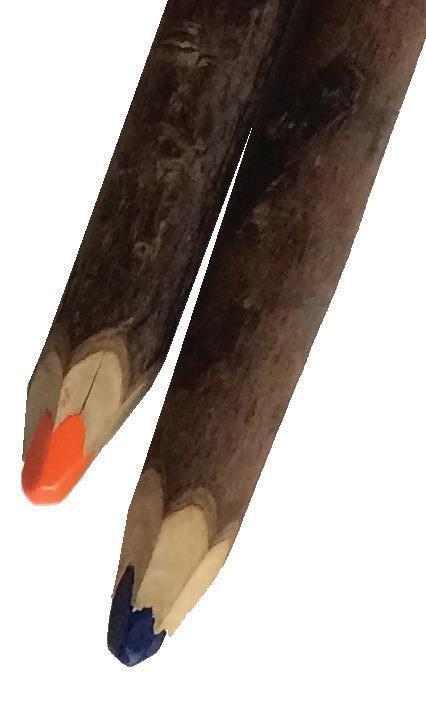


• Our drawings tell the story of our surroundings, the places we live and where we travel
• Our drawings are a record of time and place

• We are truthful to the scenes we witness
• We use any kind of media and cherish our individual styles



• We support each other and draw together
• We share our drawings online
• We show the world, one drawing at a time.
© 2023 Urban Sketchers www.urbansketchers.org